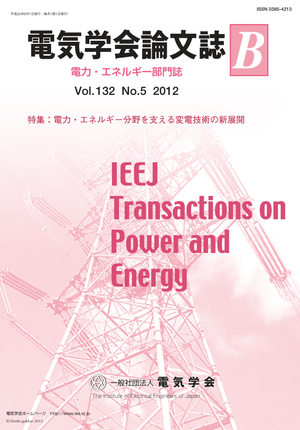FDTD法によるインパルス電圧測定系のステップ応答解析
FDTD法によるインパルス電圧測定系のステップ応答解析
カテゴリ: 論文誌(論文単位)
グループ名: 【B】電力・エネルギー部門
発行日: 2012/05/01
タイトル(英語): Step Response Analysis of an Impulse Voltage Measuring System using the FDTD Method
著者名: 岡 宏樹(同志社大学理工学部),玉野 哲弘(同志社大学理工学部),馬場 吉弘(同志社大学理工学部),石井 勝(東京大学生産技術研究所),長岡 直人(同志社大学理工学部),雨谷 昭弘(同志社大学理工学部)
著者名(英語): Hiroki Oka (College of Science and Engineering, Doshisha University), Akihiro Tamano (College of Science and Engineering, Doshisha University), Yoshihiro Baba (College of Science and Engineering, Doshisha University), Masaru Ishii (Institute of Industrial Science, The University of Tokyo), Naoto Nagaoka (College of Science and Engineering, Doshisha University), Akihiro Ametani (College of Science and Engineering, Doshisha University)
キーワード: インパルス電圧,FDTD法,ステップ応答,抵抗分圧器 impulse voltage,FDTD method,step response,resistor divider
要約(英語): Unit step responses (USRs) of a USR-measuring system recommended by the International Electro-technical Commission (IEC) have been calculated, using the finite-difference time-domain (FDTD) method, for various conditions of grounding and shield ring. The USR measuring system subject to analysis has a resistor divider of height 3.3m and resistance 9kΩ. The conductivity and relative permittivity of the laboratory floor, on which the USR measuring system is placed, are set to a range from σ = 0.001mS/m to ∞ and a range from εr = 1 to 10, respectively. It turns out that USR parameters are not much influenced by either σ or εr if σ is higher than or equal to 10mS/m, and they are close to the USR parameters for σ = ∞. When σ is lower than about 0.1mS/m, USR parameters are more influenced by σ and εr. Variations in the partial response time Tα, the experimental response time Tn, the settling time Ts, and the overshoot β, due to the differences of σ and εr, are 8ns, 14ns, 150ns, and 50%, respectively. Even if the width of horizontal ground metal sheet is extended from wg = 2 to 3m, these variations are not much reduced. The extension of the width of vertical metal sheet from wv = 1 to 2m does not much influence the USR parameters, either. Both the installing height of shield ring h and its diameter d influence the USR parameters: Tα decreases with decreasing h and/or d. Note that the FDTD-calculated USR for σ = 0.1mS/m and εr = 10 agrees reasonably well with the corresponding measured USR: Tα = 19ns, Tn = 6ns, Ts = 310ns, and β = 53% vs. Tα = 16ns, Tn = 10ns, Ts = 280ns, and β = 44%.
本誌: 電気学会論文誌B(電力・エネルギー部門誌) Vol.132 No.5 (2012) 特集:電力・エネルギー分野を支える変電技術の新展開
本誌掲載ページ: 507-514 p
原稿種別: 論文/日本語
電子版へのリンク: https://www.jstage.jst.go.jp/article/ieejpes/132/5/132_5_507/_article/-char/ja/
受取状況を読み込めませんでした


